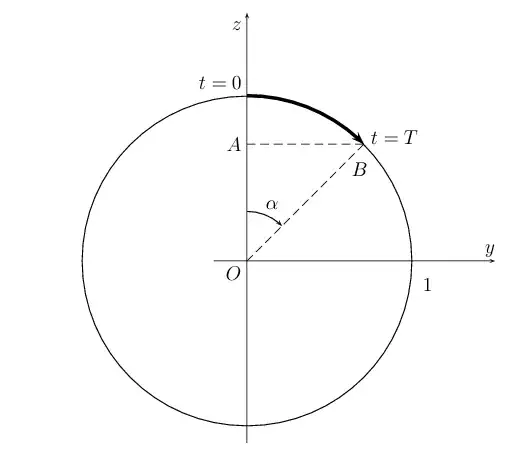We rewrite the equation as a system:
$$\tag{1}
\left\{\begin{array}{rcl}
y'&=&z\\
z'&=&-y.
\end{array}\right.
$$
The function $V(y,z)=y^2+z^2$ is a first integral of (1), i.e.
it remains constant along the trajectories of(1). Indeed,
its derivative along the trajectories is equal to zero:
$$
\dfrac{dV(y(t),z(t))}{dt}=2yy'+2zz'=2yz+2z(-y)=0.
$$
This implies that any solution $(y(t),z(t))$ of (1) (except for the only equlibrium point $y=z=0$) lies on a circle $y^2+z^2=R=\rm const$. For the solution that satisfies the initial conditions $y(0)=0$, $z(0)=1$ we have $R=y(0)^2+z(0)^2=1$.
Now look at the phase plane:

The solution that starts at the point $(0,1)$ moves clockwise because $y'(0)=z(0)=1>0$
(and it can't stop moving because the only equilibrium point is $(0,0)$).
Let us express the length $l$ of the arc traversed by the solution along the circle when changing the parameter $t$ from $0$ to $T$ (the bold arc with an arrow on the picture).
According to the curve length formula
$$
l=\int_0^{T} \sqrt{(y'(t))^2+(z'(t))^2}\,dt=
\int_0^{T} \sqrt{z^2+(-y)^2}\,dt=
\int_0^{T} 1\,dt= T,
$$
but $l=1\cdot \alpha=\alpha$, thus $\alpha=T$. This obviously implies that $y$ and $z$ are periodic with a period of $2\pi$.
Let $B$ be the point with coordinates $(y(T),z(T))$.
The opposite over hypotenuse is
$$
\sin\alpha=\frac{AB}{OB}=\frac{y(T)}{1}=y(T).
$$
